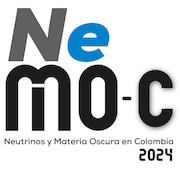Restrictions in Wilson coefficients for Dark matter simplified models
We consider an L_{\mu} - L_{\tau} abelian symmmetry extension of the Standard Model to derive spin-independent and spin-dependent interactions of fermion dark matter and electrons through the new gauge boson. We explore prospects with XLZD and OSCURA experiments to close the constraints in the parameter space able to explain simultaneously the recent measurement on the anomalous magnetic...
We explore the production of thermal dark matter (DM) candidates (WIMPs, SIMPs, ELDERs and Cannibals) during cosmic reheating. Assuming a general parametrization for the scaling of the inflaton energy density and the standard model (SM) temperature, we study the requirements for kinetic and chemical DM freeze-out in a model-independent way. For each of the mechanisms, up to two solutions that...
In one-component dark matter (DM) scenarios is commonly assumed that a scalar WIMP must either be part of an $SU(2)_L$ multiplet with zero hypercharge or have suppressed vector interactions with the $Z$ gauge boson to circumvent stringent direct detection (DD) bounds. In this work, we demonstrate that multi-component scenarios with a dark scalar doublet exhibiting vector-like interactions with...
The Kalb-Ramond (KR) field is an antisymmetric rank two tensor that appears in the context of string theory. In this work, we consider the massive KR field as a dark matter candidate and we study its production via the FIMP mechanism trough the Higgs portal. We find that the KR field gives account for the relic density of dark matter today for a wide range of masses.
We investigate a model based on fuzzy dark matter (FDM) formalism to describe rotation curves of nearby isolated dwarf galaxies. Our study evaluates the consistency of the FDM behavior with high resolution rotation curves from the LITTLE THINGS 3D catalog, which contains dark matter dominated galaxies. We find that the phenomenological model incorporating a central soliton structure, as...
In this talk we are going to provide an introduction to Fermilab computing and how to set up an account in Fermilab to use The Liquid Argon Software (LArSoft) and Its main functionalities. This tutorial will present the principal LArSoft modules used as tools in the simulation and reconstruction of different phenomena across liquid Argon time projection chambers, which are employed in...
In this talk we present an variation of the Scotogenic Model, that extends the gauge group by a global U(1) symmetry, and a singlet scalar that induces Spontaneous Symmetry Breaking to explain the origin of both Majorana Masses and Lepton number violation. Then, we make a brief analysis of the compatible parameter space for both fermionic and scalar dark matter, which can be considered in a...
I will present a triplet-scotogenic model, so called "T1-2G", in order to provide a solution to neutrino masses, and dark matter, while satisfying the limit on lepton flavor violation processes. The viable region of the parameter space is determined through a Markov Chain Monte Carlo numerical code, and satisfies both dark matter observable and lepton flavor violation constraints.
The searches for an underlying pattern in neutrino masses have motivated different proposals for textures in the neutrino mass matrix, which is also related to particular arranges of the mixing matrix. The current precise determinations of neutrino mixings have discarded some of the most studied proposals, such as the one involving a $\mu-\tau$ exchange symmetry. In this work, we investigate...
El Proyecto DUNE cuyo objetivo es ahondar en el estudio y comprensión de los neutrinos consta de un generador de haz de neutrinos captados luego por un detector cercano y posteriormente por un detector lejano. Para detectar dichas partículas se hace necesario un gran volumen de material sensible y su correspondiente hardware orientado a amplificar y digitalizar la señal de lo los eventos...
El modelo estándar de la fı́sica de partı́culas ha demostrado ser la teorı́a más exitosa de la historia, gracias a su impresionante poder predictivo y su capacidad para explicar una amplia gama de fenómenos naturales. No obstante, esta teorı́a no es definitiva y deja varias preguntas sin resolver, siendo una de las más intrigantes: ¿cómo adquieren masa los neutrinos? En este trabajo, abordamos...

